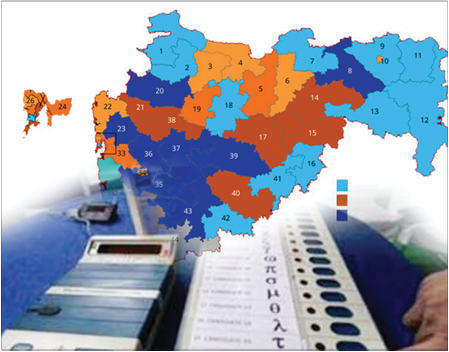The Maharashtra assembly election is crucial for Maha Yuti (MY) and Maha Vikas Aghadi(MVA) in many senses. If Maha Yuti wins this election in Maharashtra, it will give the following massage – firstly, legacy of Hindutva mobilisation is now solidly moves towards Mahayuti and Bhartiya Janata Party (BJP).
Secondly, PM Narendra Modi has still a charisma which may produce victories for National Democratic Alliance and political parties aligned with it
Thirdly, various policies for poor launched by BJP government at the Centre and Mahayuti in the state still work to retain beneficiary in their favour.
This Maharashtra state assembly election 2024 will be also a litmus test for Maha vikas aghadi(MVA), especially for Shiv sena (UBT) that whether they still has a hold for Hindutva sentiment which was cultivated by Bala Saheb Thackeray for longer time in Maharashtra politics. This election is also is going to test whether after Haryana, Congress strategy of Dalit mobilisation which is based on the discourse on danger of Constitution and reservation still contains potential for Dalit and backward mobilisation in its favour.
Like other elections in the country, in Maharashtra election too, caste matters. Various contesting political parties are trying to woo various castes and communities by giving them representation in the distribution of tickets and making promises for their share in politics and development of the state.
In Maharashtra, Marathas is the largest community containing 28 per cent of the state population. The OBCs as categories contains castes like-Kunbis(seven per cent), Malis(seven per cent),Vanjaris(six per cent) with Muslim OBCs comprises 38 per cent of the total population of the state. The Dalit communities listed in schedule caste are total 12 per cent and Aadivasies (tribal) communities are 9 per cent of the total population. The Buddhist comprises 6 per cent of the state population and are included in Schedule Castes.
However, Dalit population in Maharashtra is not so higher like the Punjab and Uttar Pradesh.
But Dalit political positioning in the state matters a lot for the politics of Dalit mobilisation in India. It is because, firstly, Maharashtra is known as pioneer of the rise of dissenting Dalit consciousness in the country. Secondly, it was land of Dalit consciousness leaders like jyoti Rao Phule and Baba Saheb Ambedkar who facilitated Dalit dissenting consciousness and Dalit movement of India. The Dalit movement like Ambedkarite Dalit movement and Dalit Panther Movement which inspired Dalit movement in different parts of India. However, the Dalit political positioning of Mahrashtra and other parts of India such as Central and Northern part of India some time appear different and contrary too.
It is popularly believed that Ambedkarites in the state especially Mahar which is the largest Dalit caste in the state remained attracted towards Congress politics in few decades of the 20th century. But in 2014 election, it is observed largest number of Dalits in the state voted for BJP.
The saffron party continued its influence among Dalits even in 2019 [ parliamentary election with minor dilution. But in 2024 parliamentary election, BJP and other NDA alies could not retain their influence among Dalits as it was earlier. The Congress generated a fear psychosis based mobilisational strategy of Dalits by aggressively producing discourse of danger on Indian constitution and reservation.
The Maha Vikas Aghadi (MVA) is trying to mobilise Dalits in their favour through two pronged strategies- firstly, by raising the issue of poverty, backwardness and employment which matters for survival and sustenance of Dalits and marginal communities in India. Secondly, by their campaign strategies, they are trying to disseminate the discourse of possible dangers on Constitution and reservation for Dalit and Backwards in BJP lead political regimes. As we know Dalit perceives Constitution as their emancipatory text which become sacred for them because of Baba Saheb Ambedkar association with its making.
The BJP and Mahayuti see the Non Mahar Dalit communities such as Matang, Mang etc as their base vote, On these base vote they are tryin to add other Dalit communities such as asection of Mahar voters who are beneficiaries of various governmental schemes launched by BJP and Mahayuti government .In fact the beneficiaries emerged as community itself which work beyond the cate and religion may provide space for BJP and Maha Yuti among various casts and communities of Schedule caste, Schedule tribe and backward social communities. The pro poor social support schemes such pension, health , PM ann yojana, majhi ladaki bahin yojana may mobilise por anddalits towards Maha yuti in impressive number. Secondly, PM Modi has acquired huge trust capital among Dalit, tribals and poor section of our society. His trust value like other elections, in this election too may attract Dalits and Marginals towards BJP and its allies of Maha Yuti.
Thirdly, quota within quota debate which Maha Yuti is trying to disseminate at the grass root may also evolve silent mobilisation of most marginal communities for BJP and its allies. The Maha yuti is trying to work on micro mobilisation strategy for mobilising various Dalit cate in its favour. To impress Buddhist and neo -Buddhist, they are propagating inclusion of Pali by the central government recently which is language of Buddhist texts and also organising Abhiddhama programmes. I see in this election BJP and Mahayuti may improve their performance among Dalit voters in this election.
Various Dalit Party like RPI(Prakash Ambedkar) etc are also trying to mobilise Dalits in their favour. These political groups may harm Congress anf Maha vikas Aghad(MVA) , not to BJP and Mahayuiti.
It is not easy to predict which direction the largest groups of Dalit will move, but it is easy to tell that their political positioning may play crucial role in giving victory to contesting political groups in this election.







